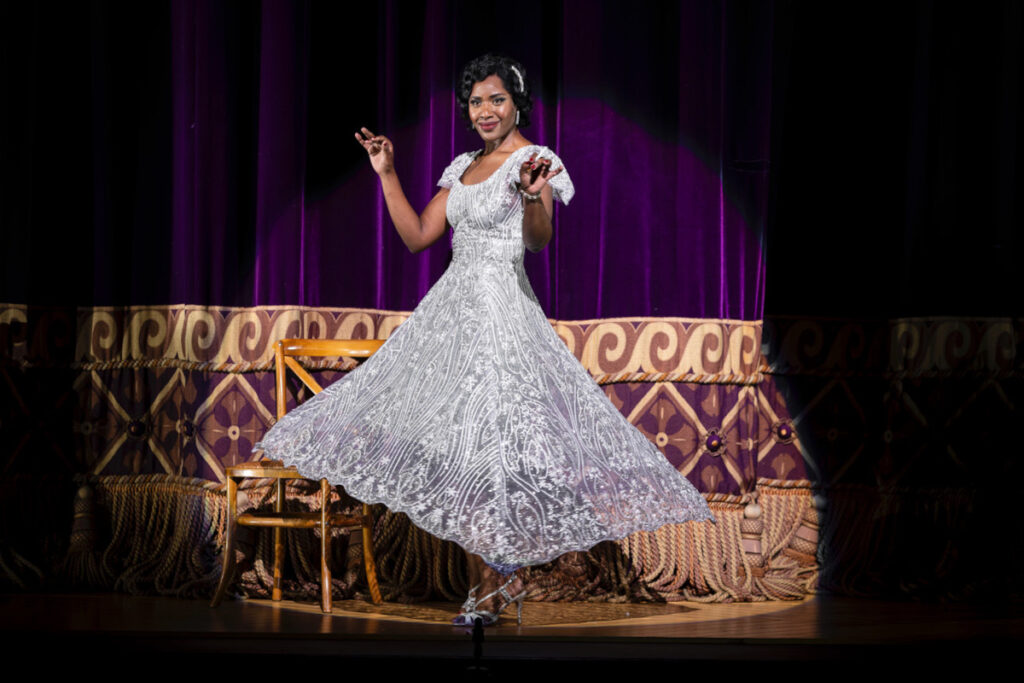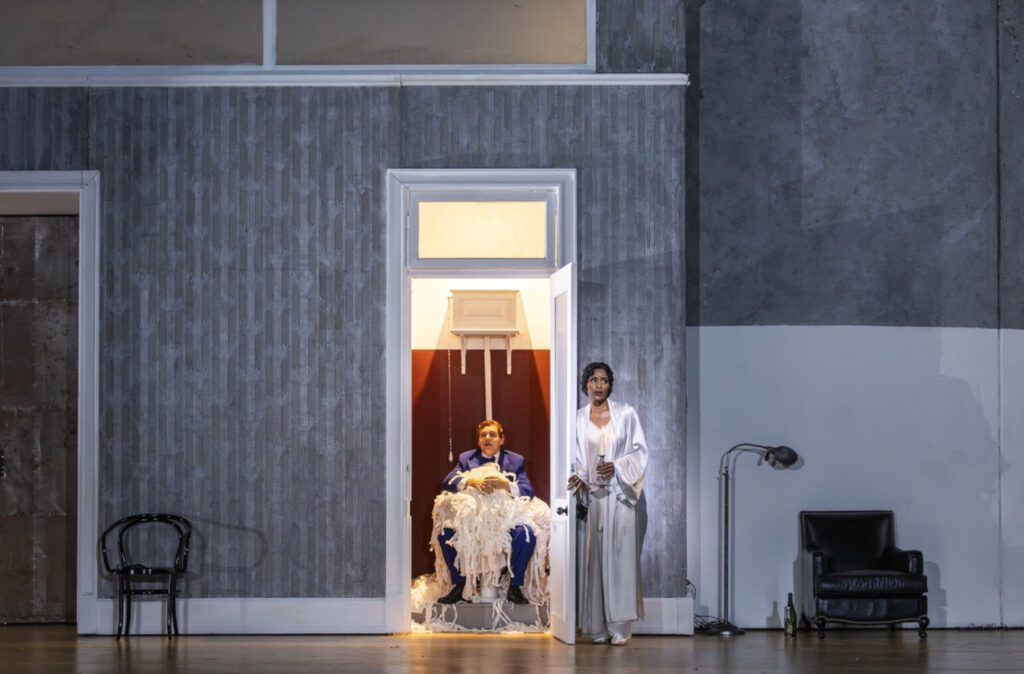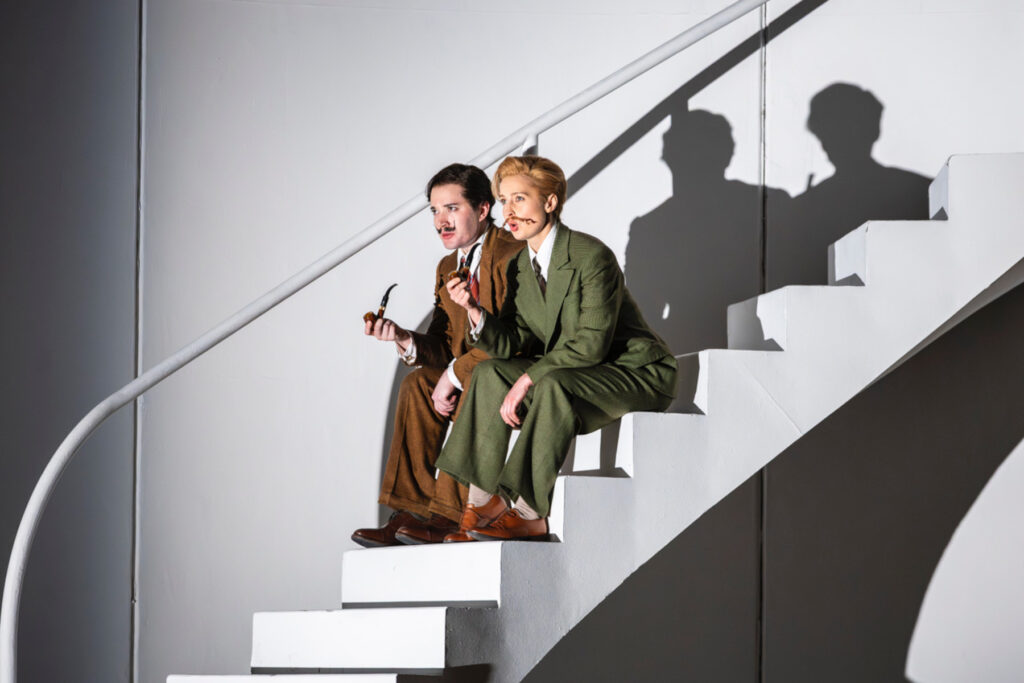Has a young woman’s search for a suitable partner got any easier these days? Victorians knew all about the role of matchmakers; a century or so previous to that debutante balls were all the rage and with them came a prized introduction to London society; now speed dating in café environments or staring at faces on online websites are de rigueur in certain circles, and if you come from a different cultural background to the mainstream you might place your faith in arranged marriages. Imagine how difficult it would have been for the Queen of Naples, one Partenope, struggling to choose amongst her four suitors. Who could she really trust in an age when it simply wasn’t possible to Google names on the internet or demand evidence of a clean CRB (or DBS) check? Nor was it any easier in the inter-war years, Christopher Alden’s chosen time setting for this ENO production of Partenope, first staged in 2008 and revived in 2017. Back then, if a young woman went anywhere socially, she generally needed a chaperone, otherwise she was regarded as fair game.

Making the story relevant to present-day audiences is what stage directors routinely set out to do. Does imposing a set of surrealist influences make this Handel opera and the admittedly somewhat convoluted plot more meaningful? There I have my doubts. Andrew Lieberman’s sets, however, are easy on the eye and anchor matters clearly in the Art Deco period. Act 1 offers a classy, Parisian-style salon, with a winding cantilever staircase in one corner, its open stairs providing multiple opportunities for Partenope’s hopefuls to cavort around and engage in jaw-dropping gymnastic exercises, while the stage space is dominated by ebony-coloured chairs and a table topped in white marble, over which hangs a period candelabra. Act 2 moves the action into two connecting vestibules, the previously bare white walls now papered, an antique French stove on the side, a centrally placed lavatory replete with transom window and a visible top floor enabling entrances and exits. Act 3 takes on a closed-in appearance, dominated by rectangles cut from a blown-up period photograph of a woman’s upper torso and left nipple which are being assembled from a ladder by Emilio, Prince of Cumae, here modelled on the American visual artist Man Ray (aka Emmanuel Radnitzky).
Jon Morrell’s costumes are a delight to look at. Partenope initially wears an elegant two-piece, coffee-coloured outfit; later on she appears variously in tails and a top hat, white silken nightwear and a glittering lamé gown. The men are clad in distinctive coloured suits: blue for Arsace, Prince of Corinth; brown for Armindo, Prince of Rhodes; grey for Emilio; wine-red for Partenope’s chief guard Ormonte; and green for Rosmira, Princess of Cyprus, disguised as Eurimene. References to gender fluidity and cross-dressing are reflected in Act 3 in Emilio’s patterned skirt and Ormonte’s hooped pink dress, making him look like an errant member of the Swiss Papal Guard. These days nothing would be complete without homoerotic associations: Ormonte standing below catches sight of Armindo disrobing completely on an upper level and rushes off to investigate further.

Period details are well observed. All the characters smoke, almost incessantly; if not cigarettes, then in the case of Armindo and Eurimene hawkbill smoking pipes. A Pickelhaube helmet is introduced, further adorned by a bunch of bananas on Ormonte’s head in the final act. Cocktail shakers, bottles of spirit and platters of canapés indicate a hedonistic lifestyle. Emilio carries a contemporary-style camera and flashlight, and operates a ciné-projector in Act 3. Perhaps the most touching integration of visual detail with Handel’s score comes in this final act when Arsace opens up a wind-up gramophone, places a shellac disc on the turntable and sings of his inner torment, as the orchestral accompaniment with flute solo and pizzicato lower strings enhance his lament.
There is a lot of movement; nowhere does a sense of stasis affect proceedings. I have rarely seen such elegant locomotion by a character on stage as in the case of Partenope: often moving like a graceful gazelle, extending each of her long legs enticingly, stretching her upper limbs sensuously, nimble and agile throughout. Her stage manner frequently suggested an awareness of a hidden camera while posing for striking photographs. Slow-motion steps emphasise alterations in pace; slapstick elements like a Cabaret-style sequence for Armindo involving tap-dancing and a concluding somersault drive up energy levels. Above all, Alden has found a neat solution for the many da capo features of the score, requiring additional movement and changes in focus to provide visual variety.

On the debit side I was irritated by some of the super-imposed detailing. While her suitors are gathered at the Act 1 table playing a game of cards, Partenope hands out gas-masks (with cut-out masks used later); Eurimene removes and then brandishes a bra, later smashing two bottles against a wall and upending a chair in expressions of fury. When Ormonte peels a banana and holds it perfectly upright, the phallic symbolism is anything but subtle. Drawing Matisse-like charcoal squiggles on a white wall inside a salon and attempting to crown parts of them with a picture-frame were nods to a deeper symbolism that was sadly beyond my understanding. Nor was I persuaded that repeated episodes in the lavatory, culminating in Partenope discovering Arsace there, having covered himself in reams of loo paper, added anything of significance.
Amanda Holden’s English translation aids rather than hinders the narrative progression, with rhymes that are not too obvious (such as Armindo’s “What a sticky situation, Love creates such irritation”), and only occasional blemishes. Partenope’s “Will you shut up?” addressed to Eurimene is not exactly lady-like, nor did I think that in one of the recitatives between Eurimene and Arsace a reference to “You traitor, little shit” was entirely appropriate.
Which takes us on to the singing. It is an indication of the high vocal quality of this and other more recent ENO productions that in terms of technique and characterisation little was left to be desired. Partenope has to sing eight taxing arias during the course of this opera: in this role Nardus Williams was undoubtedly the star of the show. In her first aria, “L’Amor ed il Destin”, she doubts that destiny and love can battle successfully in her name. The succession of her impeccably pitched coloratura runs created ripples of erotic tension in the air. Eyes were always drawn to her magnetic appearance. This regal individual struggles with the competing claims from the male characters that surround her, expressed most vividly in her Act 2 aria, “Qual farfalletta”, in which she declares herself to be as flighty as moths in the moonlight. Williams’s evenness of line as the waves of heartache engulf her was quite remarkable. In her final aria, sung in front of the curtain, she addressed the audience directly, commenting on Cupid’s darts of both joy and passion, yet with one clear message to all: “Don’t let passion ever wane”.

As the only other female character, Katie Bray’s Eurimene (until her uncloaking as Rosmira) was a bundle of energy, a veritable vocal firecracker, easily conveying her sense of treachery at the hands of her former lover Arsace, and displaying wonderfully powerful low chest tones for “You betrayed me”. In her Act 1 aria, “lo seguo sol fiero”, all the pent-up feeling of a woman scorned was manifest, but equally impressive was the dark colouring she found for expressions of her jealousy at the growing closeness between Arsace and Partenope. In her Act 3 aria, “Quel volto mi piace”, the conflict in her inner feelings at being abandoned but then won over once more was sincerely conveyed.
Arsace is often portrayed as something of a heartbreaker and a cad (Holden’s translation refers to him as a bounder), but Hugh Cutting’s assumption of this role was multi-faceted. His very flexible countertenor was used intelligently throughout, his many florid lines delivered like molten streams of suggestiveness, but it was his inner torment too, his almost childlike sense of consternation and bewilderment, that shone through much of his characterisation, not least in his Act 3 aria “Ch’io parta?”, where his depths of despondency (“I leave without my heart”) were movingly revealed.
I also enjoyed Jake Ingbar’s playfulness as Armindo. In his ENO debut this American countertenor moved from the shadows of shyness to full-throated conviction, revelling in opportunities for comic inventiveness, as in his Act 1 aria, “Voglio dire al mio tesoro”, delivered while clinging perilously to the staircase, and culminating in quiet ecstasy when Partenope shares his love. Armindo’s first foray into a deeper relationship is graced with feelings of deep sincerity.
Ru Charlesworth sang a vibrant Emilio, his secure tenor line capped by a thrilling top line as he revealed his determination to go into battle to win over Partenope, “with valour at my side, not ammunition”. His sure-footed characterisation was most apparent in the exasperation he poured into his Act 2 aria, “Barbaro fato”, all the florid lines at speed seething with vexation.
William Thomas has a wonderfully strong and warm bass, providing a marked contrast here with the other, much lighter vocal lines. As Partenope’s chief guard Ormonte, however, I did sometimes feel his presence just a little intrusive. Guards can be figures of fun and entertainment in regal houses, but would they really be seated at the same table playing cards with the princely suitors? Thomas had a nice line in ballet steps with a pair of crossed swords and he produced quite cavernously rich sounds from his deepest register, but in my mind’s eye I saw him better cast as Sarastro.
Christian Curnyn conducted a nuanced account of Act 1, with some weighty lines in the orchestral playing, accompanied by the three continuo players (cello, theorbo and harpsichord). Unfortunately, he was taken ill during the first interval and replaced for the remaining two acts by the assistant conductor William Cole, who seemed to drive matters along with increased levels of energy but without much dynamic flexibility.
In its promotional material ENO makes use of the term rom-com. Handel’s opera shares a comic plot with many other Baroque farragos in which everybody seems to be in love with someone else. Yes, love is complicated, and it can often be a battleground for passionate involvements, but Partenope would be less of an achievement – and it is technically an opera seria – if it didn’t explore some of the deepest emotions that human beings can experience. In this fine production there is much to reflect on.
Alexander Hall
Partenope
Opera seria in three acts to a libretto by Silvio Stampiglia in an English translation by Amanda Holden
Music by George Frideric Handel (HWV 27)
Sung in English with English surtitles
Cast and Production Staff:
Partenope – Nardus Williams; Arsace – Hugh Cutting; Emilio – Ru Charlesworth; Armindo – Jake Ingbar; Eurimene/Rosmira – Katie Bray; Ormonte – William Thomas
Director – Christopher Alden; Set Designer – Andrew Lieberman; Costume Designer – Jon Morrell; Lighting Designer – Adam Silverman; Movement Director – Claire Glaskin; Revival Movement & Intimacy Director – Elaine Brown; Orchestra of English National Opera; Conductors – Christian Curnyn & William Cole
English National Opera, Coliseum, London, 20 November 2025
Further performances until 6 December
Top Image Nardus Williams as Partenope, Jake Ingbar as Armindo, and Ru Charlesworth as Emilio
All photos © Lloyd Winters